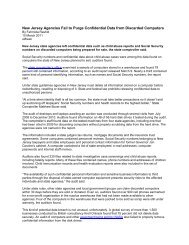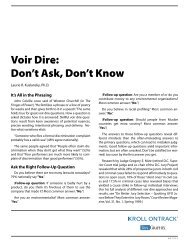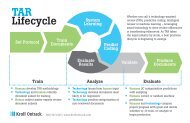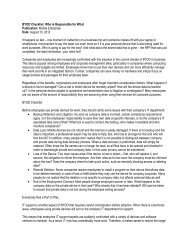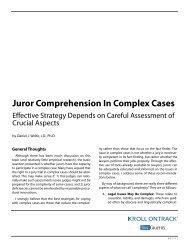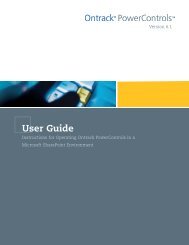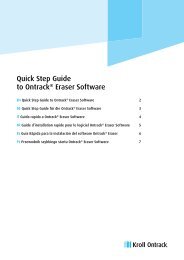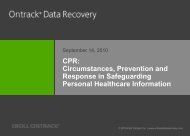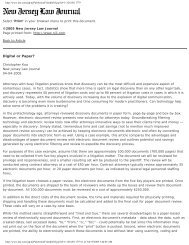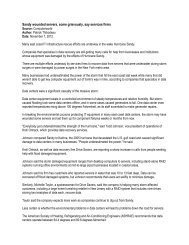Digging for e-data - Kroll Ontrack
Digging for e-data - Kroll Ontrack
Digging for e-data - Kroll Ontrack
Create successful ePaper yourself
Turn your PDF publications into a flip-book with our unique Google optimized e-Paper software.
<strong>Digging</strong> <strong>for</strong> e-<strong>data</strong> i<br />
Kristin M. Nimsger ii<br />
You won’t find ‘electronic evidence’ and ‘e-discovery’ in the latest edition of Black’s<br />
Law Dictionary. Knowing what they are and how to use them may save your client’s<br />
case, and your practice.<br />
Plaintiff lawyers with busy trial practices often operate in a head-down, shoulder-to-thegrindstone<br />
fashion. Managing a heavy caseload plus an office can take so much energy<br />
and time that keeping up with litigation trends may seem impossible. If this sounds like<br />
you, you probably haven’t examined both the promise and the peril that electronic<br />
evidence can hold <strong>for</strong> your clients’ cases: You may be setting them up <strong>for</strong> a fall and<br />
putting yourself at risk <strong>for</strong> a malpractice claim.<br />
In 2001, businesses in North America sent an estimated 2.5 trillion e-mail messages,<br />
expected to grow to 3.25 trillion in 2002. iii Ninety-three percent of all business<br />
documents are created electronically, iv and most are never printed. v But that doesn’t mean<br />
copies aren’t being made. Almost all businesses and many individuals have learned the<br />
importance of backing up electronic <strong>data</strong> regularly—even daily. The result: copies upon<br />
copies of electronic evidence that may be relevant in litigation.<br />
Let’s say you suspect a defendant has electronic <strong>data</strong> that could help your client’s case.<br />
How do you get access to it? If you don’t know, you may miss out on critical evidence.<br />
Or let’s say your client receives a request to produce electronic <strong>data</strong> that is clearly<br />
discoverable. vi How do you proceed? What if your client routinely deletes or writes over<br />
<strong>data</strong>? How do you protect the client from committing spoliation by unwittingly erasing or<br />
destroying electronic evidence relevant to pending litigation—and consequently risking<br />
sanctions, including dismissal of the complaint or default judgment on a counterclaim?<br />
Heads up: It’s time to learn what you need to know about electronic evidence to protect<br />
your clients’ interests and avoid the potentially catastrophic results of ignorance and<br />
inaction.<br />
Getting the e-goods<br />
E-discovery can produce a treasure trove of evidence. The discovery of just one e-mail<br />
message can trans<strong>for</strong>m a contentious legal battle into settlement discussions. For<br />
example, in Linnen v. A.H. Robins Co., the family of a woman who died after taking the<br />
diet pill combination of the prescription drugs fenfluramine and phentermine (known as<br />
fen-phen) sued the drugs’ makers. The plaintiffs claimed the drugs, taken in combination,<br />
caused the woman to develop a deadly lung disorder. vii Computer <strong>for</strong>ensic engineers hired<br />
by the plaintiffs were able to recover an e-mail from one A.H. Robins employee to<br />
another that read: “Do I have to look <strong>for</strong>ward to spending my waning years writing<br />
checks to fat people worried about a silly lung problem?” viii Shortly after this revelation,<br />
the case settled.
Linnen is not an isolated case. E-mail and other types of electronic evidence are at the<br />
center of many well-publicized lawsuits. For example, in the Bridgestone/Firestone<br />
multidistrict litigation concerning allegedly defective tires on Ford Explorers, the court<br />
has ordered specifically how electronic evidence will be handled. ix<br />
So what do you do when you think e-evidence may be central to your case and it’s in the<br />
hands of the defendant? First, look to the federal rule governing initial disclosures—<br />
Federal Rule of Civil Procedure 26. Because jurisdictions may no longer “opt out” of the<br />
disclosure requirement, attorneys must address the impact of this rule on electronic<br />
evidence. x Even if a case is in state court, this rule and other relevant federal rules<br />
discussed below may apply because state rules often mirror the federal rules. Some states<br />
(<strong>for</strong> example, Cali<strong>for</strong>nia and Texas) have special rules addressing electronic evidence.<br />
Federal Rule 26(a)(1)(B) specifically requires the disclosure of “<strong>data</strong> compilations” (<strong>for</strong><br />
example, electronic files, <strong>data</strong>bases, and e-mails) after a full investigation of the case.<br />
This imposes a duty on attorneys to identify all sources and locations of electronic <strong>data</strong> in<br />
their clients’ possession. xi<br />
Data will commonly be located on desktop and laptop computers, network hard drives,<br />
removable media (like floppy disks, tapes, and CD-ROMs), and, increasingly, personal<br />
digital assistants like the PalmPilot. Data may also be in the possession of third parties,<br />
including Internet service providers and other peripherally involved entities.<br />
Determining how much e-mail and other electronic <strong>data</strong> is in a defendant’s control can be<br />
difficult without the assistance of an experienced electronic discovery expert. However,<br />
this in<strong>for</strong>mation is essential <strong>for</strong> compliance with Rule 26(f), which requires all parties to<br />
meet to discuss a discovery plan. To do this, attorneys will need to understand how their<br />
client’s in<strong>for</strong>mation systems create, store, and destroy electronic evidence. If the<br />
defendant has not produced this in<strong>for</strong>mation, you can ask the court to compel compliance<br />
with the rule.<br />
Under Rule 26(a)(2), the parties must also disclose the identities of their e-discovery or<br />
<strong>for</strong>ensic experts, or risk not being able to call them to testify at trial. Obviously, any<br />
person who has per<strong>for</strong>med a <strong>for</strong>ensic analysis of the parties’ hard drives or other systems<br />
falls within the scope of this rule. The more interesting issue is whether one must disclose<br />
the identity of an expert who handles the collection and reproduction of electronic <strong>data</strong><br />
without conducting any sort of <strong>for</strong>ensic analysis. These experts clearly possess the kind<br />
of “scientific, technical, or other specialized knowledge” contemplated by Federal Rule<br />
of Evidence 702.<br />
After the Rule 26 disclosures, you can acquire more in-depth in<strong>for</strong>mation through a<br />
combination of traditional discovery tools: interrogatories, requests <strong>for</strong> production of<br />
documents, and depositions. xii The Rule 30(b)(6) deposition is an excellent tool <strong>for</strong><br />
obtaining more in<strong>for</strong>mation about the layout of the defendant’s computer system to guide<br />
further discovery. If the defendant is a company, depose the person who would have the<br />
most knowledge of:
•<br />
•<br />
•<br />
•<br />
•<br />
•<br />
•<br />
•<br />
•<br />
•<br />
•<br />
•<br />
•<br />
•<br />
•<br />
the number, types, and locations of computers currently in use and no longer in<br />
use.<br />
the operating systems and application software the company is using, including<br />
the dates of use.<br />
the company’s file-naming and location-saving conventions.<br />
disk- or tape-labeling conventions.<br />
backup and archival disk or tape inventories or schedules.<br />
the most likely locations of electronic records relevant to the subject matter of the<br />
case.<br />
backup rotation schedules and archiving procedures, including any backup<br />
programs in use at any relevant time.<br />
electronic-records-management policies and procedures.<br />
corporate policies regarding employee use of company computers and <strong>data</strong>.<br />
the identities of all current and <strong>for</strong>mer employees who have or had access to<br />
network administration, backup, archiving, or other system operations during the<br />
relevant period.<br />
Once you have this in<strong>for</strong>mation, you can refine your discovery requests to obtain relevant<br />
<strong>data</strong> from the locations and systems identified in the deposition. Under the amended<br />
Federal Rules of Civil Procedure, requests <strong>for</strong> electronic <strong>data</strong> should be carefully crafted.<br />
A request <strong>for</strong> “all electronic <strong>data</strong>” will likely result in an objection based on burden or<br />
expense, and courts have been inconsistent on how deeply they will allow a discovering<br />
party to dig. xiii There<strong>for</strong>e, discovery requests must be specific and exhibit an<br />
understanding of how electronic <strong>data</strong> are created, stored, and destroyed.<br />
The particular type of electronic <strong>data</strong> in the defendant’s possession that you may want to<br />
look at will vary depending on the issues in controversy. However, you should consider<br />
the following categories of evidence when crafting your requests <strong>for</strong> production:<br />
•<br />
e-mail (sent, received, or drafted) and corresponding dates, times, recipients, and<br />
file attachments<br />
word-processing files<br />
tables, charts, graphs, and <strong>data</strong>base files<br />
electronic calendars<br />
proprietary software files<br />
Internet browsing applications (bookmarks, cookies, history log).<br />
After you have collected these <strong>data</strong>, e-evidence experts using the latest technology can<br />
drill down through the layers of in<strong>for</strong>mation to find the most salient tidbits relating to the<br />
issues in your case. For example, the <strong>data</strong> can be mined to locate files created by a certain<br />
user, having certain file extensions, created within specific dates, or containing relevant<br />
keywords. Computer <strong>for</strong>ensic tools can even restore deleted e-mails or files.<br />
One of the most useful electronic-discovery management tools may be the pretrial<br />
conference required by Federal Rule of Civil Procedure 16. As with the Rule 26(f)<br />
meeting on discovery, both parties should be prepared to provide the court with expert
testimony regarding the nature, location, and volume of electronic <strong>data</strong>, as well as the<br />
time and cost involved in producing it. Doing so will help limit the scope of discovery<br />
required from your client while maximizing the disclosures that are required from the<br />
defendant.<br />
Topics <strong>for</strong> discussion at the Rule 16 conference may include preservation of evidence<br />
(including whether backup, archival, and deleted files will be exchanged), preliminary<br />
disclosures as to the parties’ computer systems (including numbers, types, and locations<br />
of computers, operating systems in use, and backup schedules), document-processing and<br />
production <strong>for</strong>mats, testifying experts, cost allocation, and anticipated evidentiary<br />
disputes. The conference can be used to your client’s advantage to gain an understanding<br />
of the defendant’s electronic records management procedures or, at the very least, to<br />
gauge the degree to which the defendant is prepared to address electronic evidence in<br />
your case.<br />
Avoiding pitfalls<br />
Spoliation claims are usually leveled at a defendant, but many a plaintiff has lost a case<br />
be<strong>for</strong>e it was filed by failing to preserve relevant evidence. Defendants are increasingly<br />
pursuing e-evidence from plaintiffs—like personal e-mail saved on home computers,<br />
in<strong>for</strong>mation stored on personal digital assistants, and cell phone logs—so you must<br />
caution your clients to beware the consequences of failing to adequately preserve<br />
electronic <strong>data</strong> in their possession.<br />
Unlike paper documents, which require an overt act like shredding to be destroyed,<br />
electronic <strong>data</strong> can be and often are destroyed by routine computer use. Simply turning<br />
on a personal computer can destroy “slack” and “temporary” files, cause <strong>data</strong> to be<br />
overwritten, or alter meta<strong>data</strong> (<strong>for</strong> example, <strong>data</strong> showing when a file was created or<br />
modified). Clicking on a file can change its “last-accessed” date, inviting a suggestion<br />
that it has been altered. xiv<br />
You can help your clients protect themselves against a potential spoliation accusation and<br />
its consequences by telling them to immediately halt all electronic document-handling<br />
policies that result in the recycling of potentially relevant tapes or other e-<strong>data</strong><br />
destruction. An e-discovery expert can help explain which policies or actions are<br />
potentially harmful.<br />
Consider suggesting that the <strong>data</strong> on the client’s hard drive be preserved using mirrorimaging<br />
technology, available from most reputable e-discovery and computer <strong>for</strong>ensics<br />
experts. This freezes the <strong>data</strong> like a snapshot. This is especially helpful if the client is a<br />
company that employs many computer users, because it avoids having to train each<br />
employee in e-<strong>data</strong> preservation and allows work to continue on the company’s<br />
computers even with a preservation order in place. xv Data preservation issues arise mostly<br />
in business tort lawsuits; however, plaintiff lawyers should also be aware of proper<br />
preservation protocols to ensure that their corporate opponents are using the best<br />
practices when preserving key <strong>data</strong>.
Another potential pitfall <strong>for</strong> plaintiff attorneys whose clients have relevant electronic<br />
documents is inadvertent production. A critical aspect of any digital discovery plan<br />
addresses the potential <strong>for</strong> inadvertent waiver of privileged in<strong>for</strong>mation. Plaintiffs can<br />
take the lead on this issue by gaining an agreement or a court order in advance of<br />
discovery stating that the inadvertent disclosure of a privileged document does not<br />
constitute a waiver of privilege, that the privileged document should be returned, and that<br />
any notes relating to the document or copies of it made by an opponent will be destroyed.<br />
With 70 percent of all written <strong>data</strong> now stored in electronic <strong>for</strong>m, xvi gone is the day when<br />
an attorney is likely to find the “smoking gun” document in a box located in a remote<br />
storage facility. Plaintiff lawyers who continue to ignore this reality risk defeat <strong>for</strong> their<br />
clients and damage to their reputations. Those who take the time to learn what e-evidence<br />
is, how to find it, and how to use it will increase their chances of uncovering the<br />
in<strong>for</strong>mation that wins the case.<br />
i Reprinted with permission of TRIAL (January 2003). Copyright the Association of Trial Lawyers of America.<br />
ii Kristin M. Nimsger is the electronic evidence project line manager at <strong>Kroll</strong> <strong>Ontrack</strong>, Inc., in Eden Prairie, Minnesota.<br />
She can be reached at knimsger@ krollontrack.com.<br />
iii Elizabeth Weinstein, Help! I’m Drowning in E- Mail, WALL ST. J., Jan. 10, 2002, at B1, available at<br />
http://webreprints.djreprints.com (last visited Nov. 20, 2002).<br />
iv KEVIN CRANE, DESIGNING A DOCUMENT STRATEGY (2000).<br />
v Lori Enos, Digital Data Changing Legal Landscape, E-COMMERCE TIMES, May 16, 2000, at<br />
www.ecommercetimes.com/perl/story/3339.html.<br />
vi Simon Prop. Group v. mySimon, Inc., 194 F.R.D. 639 (S.D. Ind. 2000); Linnen v. A.H. Robins Co., No. 97-2307,<br />
1999 WL 462015 (Mass. Super. Ct. June 16, 1999); Playboy Enters., Inc. v. Welles, 60 F. Supp. 2d 1050 (S.D. Cal.<br />
1999); Anti-Monopoly, Inc. v. Hasbro, Inc., No. 94 Civ. 2120, 1995 WL 649934 (S.D.N.Y. Nov. 3, 1995); Crown Life<br />
Ins. Co. v. Craig, 995 F.2d 1376 (7th Cir. 1993); Santiago v. Miles, 121 F.R.D. 636 (W.D.N.Y. 1988); Bills v.<br />
Kennecott Corp., 108 F.R.D. 459 (C.D. Utah 1985).<br />
vii Linnen, No. 97-2307, 1999 WL 462015.<br />
viii ALICIA MUNDY, DISPENSING WITH THE TRUTH (2001).<br />
ix See In re Bridgestone/Firestone, Inc., Tires Prods. Liab. Litig., No. MDL 1373 (S.D. Ind. Jan. 30, 2001), at<br />
www.insd.uscourts.gov/firestone/bf_docs/93730480.pdf (last visited Nov. 20, 2002).<br />
x Be<strong>for</strong>e the Federal Rules of Civil Procedure were amended in 2000, Rule 26 contained a clause allowing individual<br />
districts to opt out of the initial disclosure requirement.<br />
xi Kleiner v. Burns, No. 00-2160-JWL, 2000 WL 1909470 (D. Kan. Dec. 15, 2000).<br />
xii Sample electronic-discovery interrogatories can be found at<br />
http://www.krollontrack.com/practicaltools/interrogatory_mailer.pdf.interrogatory_mailer.doc.<br />
xiii Playboy Enters., Inc., 60 F. Supp. 2d 1050; Van Westrienen v. Americontinental Collection Corp., 189 F.R.D. 440<br />
(D. Or. 1999); Symantec Corp. v. McAfee Assoc., Inc., No. C-97-20367-JF (EAI), 1998 WL 740807 (N.D. Cal. Aug.<br />
14, 1998); Fennell v. First Step Designs, Ltd., 83 F.3d 526 (1st Cir. 1996).<br />
xiv In re Prudential Ins. Co. Sale Practices Litig., 169 F.R.D. 598 (D.N.J. 1997); Proctor & Gamble Co. v. Haugen, 179<br />
F.R.D. 622 (D. Utah 1998).<br />
xv Gates Rubber Co. v. Bando Chem. Ind., 167 F.R.D. 90 (D. Colo. 1996).<br />
xvi See CRANE, supra note 2.




